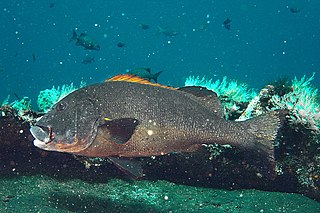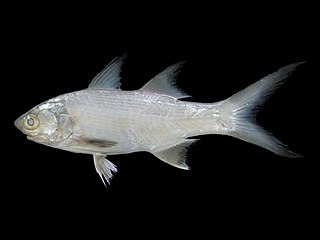
Threadfins are silvery grey perciform fish of the family Polynemidae. Found in tropical to subtropical waters throughout the world, the threadfin family contains eight genera and about 40 species. An unrelated species sometimes known by the name threadfin, Alectis indicus, is properly the Indian threadfish.

The Atlantic threadfin is a species of ray-finned fish a threadfin from the family Polynemidae which is native to subtropical and temperate waters of the western Atlantic Ocean and the Gulf of Mexico.

Eleutheronema tetradactylum, the fourfinger threadfin, is a species of marine ray-finned fish, a threadfin from the family Polynemidae which occurs in the Indian and western Pacific Ocean.

Plectorhinchus albovittatus, the two-striped sweetlips or giant sweetlips, is a species of marine ray-finned fish, a sweetlips belonging to the subfamily Plectorhinchinae, part of the grunt family Haemulidae. It is native to the Indian Ocean and the western Pacific Ocean.

The giant African threadfin is a species of ray-finned fish from the threadfin family Polynemidae. It is found in the eastern Atlantic Ocean off the west coast of Africa.

Polydactylus sexfilis, the six-finger threadfin or yellowthread threadfin, is a species of marine ray-finned fish, a threadfin from the family Polynemidae which is found in the Indian and Pacific Oceans.

The King threadfin, also known as the blind salmon, blink tassel-fish, burnett salmon, gold threadfin, king salmon, kingfish, Sheridan threadfin, triped tassel fish, or threadfin salmon, is a species of marine ray-finned fish, a threadfin from the family Polynemidae which is found in southern New Guinea and northern Australia.

The longfin grouper, also known as the longfin rockcod, bar-breasted rock-cod, Gilbert's rock-cod, honeycomb rockcod, spotted groper or wirenet cod, is a species of marine ray-finned fish, a grouper from the subfamily Epinephelinae which is part of the family Serranidae, which also includes the anthias and sea basses. It is found in the Western Pacific Ocean.

The slender fusilier is a species of marine ray-finned fish, a fusilier belonging to the family Caesionidae. It is native to tropical reefs in the Indian Ocean and the western Pacific Ocean, It is of minor importance to local commercial fisheries. This species is the only known member of its genus.
The blackspotted hawkfish is a species of marine ray-finned fish, a hawkfish belonging to the family Cirrhitidae. It is native to rocky shores of the western Indian Ocean. This species grows to 17 cm (6.7 in) in total length. This species is the only known member of its genus.

Polynemus multifilis, the elegant paradise fish is a species of ray-finned fish, a threadfin from the family Polynemidae which is found in rivers in southeast Asia.
Polynemus aquilonaris, commonly known as the northern paradise fish, is a fish of the threadfin family Polynemidae. It is native to the large rivers of mainland Southeast Asia.

Polydactylus sextarius, the blackspot threadfin, is a species of marine ray-finned fish, a threadfin from the family Polynemidae which is native to the western Pacific and eastern Indian Oceans.

Polydactylus plebeius, the striped threadfin, also known as the common threadfin, Northern threadfin or puttynose, is a species of marine fish native to the Indo-Pacific.
Bidyanus welchi, commonly known as Welch's grunter, black bream, or silver bream, is a species of freshwater ray-finned fish from the family Terapontidae native to Australia.
The dwarf paradise fish, also known as the streamer threadfin or streamered tasselfish, is a species of ray-finned fish from a family Polynemidae, the threadfins. It is the only species in the genus Parapolynemus and it is found in Australia and New Guinea.

Polynemus is a genus of threadfins. They are native to South and Southeast Asia and, depending on the species, occur in freshwater, brackish, and/or marine environments.

The paradise threadfin is a species of catadromous ray-finned fish, a threadfin from the family Polynemidae which is found in south and southeast Asia in freshwater rivers where it is a valued food fish.

Filimanus is a genus of marine ray-finned fishes, threadfins from the family Polynemidae.

The royal threadfin is a species of ray-finned fish, a threadfin from the family Polynemidae, the threadfins. It is found in the eastern Atlantic Ocean along the western coast of Africa.













